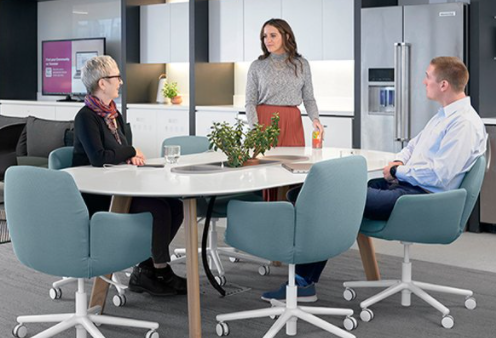The Well-being of People and Planet Drives the Top Trend
The disruption of the COVID-19 pandemic has people and organizations reassessing what’s most important to them. The ways we work, live, and play are shifting as people choose what’s best for their well-being and the planet. Here are 8 top trends we we’re seeing in 2022.
1. Urban Transformation
Even before the COVID-19 pandemic, urban areas faced many challenges—from population density, shrinking real estate, and increasing housing costs to aging infrastructures, sustainability issues, and inequities. Yet people are resilient—and creative. One example is a new neighborhood in Draper, UT that embodies the ideal of a 15-minute city, which makes it easy to do everyday errands within the distance of a short walk or bike ride.
Another trend is commercial crossover spaces like Buckle Street Studios by Locke in London, which caters to remote workers who choose to stay in a studio, hotel room, or apartment and have the convenience to work how they want, as well as nearby dining and shopping.
2. Carbon Revolution
Sustainability and clean energy efforts have increasingly ramped up over the last several years. One driver of this trend is younger consumers who actively seek climate-neutral and regenerative products for everyday purchases—like the vegan leather derived from mushrooms produced by MycoWorks.
There’s also a growing willingness among consumers to purchase secondhand products that includes furniture, major appliances, and apparel. Used goods seller FloorFound reports more brands are viewing “recommerce” as an opportunity to reduce waste, overcome supply chain challenges, increase brand loyalty, and generate income.
3. Digital Upskilling
“New collar jobs” as coined by IBM are those that rely less on degrees or credentials and more on skills. Google, Apple, and Tesla have all announced that workers don’t need a college degree to get a job. The emphasis is now on skills and analytic ability. These are the new qualifications needed to succeed in the fast-growing fields of cybersecurity, cloud computing, and digital design.
Digital upskilling will also be necessary. McKinsey & Company reports that 33% or more of all existing jobs worldwide will be transformed by technology in the next decade. Organizations with cultures that focus on training for current employees will be better positioned for success.
4. Hybrid Work
People want to work from home and at the office—or anywhere they choose—depending on their needs for a given day. The pandemic forced many to quickly adapt to working from home, and they did so quite effectively. Yet many people want to be in the office, at least some of the time, for very good reasons.
When a Fall 2021 US Workplace Survey asked people why they feel like they need to be in office, the top five reasons were to:
- Make key connections
- Feel included
- Avoid missing out
- Advance my career
- Be visible for promotion consideration
5. Neuro Equity
Many people with ADHD, anxiety, autism, and PTSD—as well as good portion of general workforce—experience sensory processing sensitivity (SPS). They tend to feel more intense responses to stimuli, putting them at higher risk for burnout.
To enhance the sensory experience, workplace and retail designers are exploring ways to engage the senses through pleasing neuroaesthetics. High-touch materials, soundtracks, and even aromas can be used to create more comfortable spaces. Also, seamless transitions between indoor and outdoor workspaces are getting more attention as way to support worker well-being.
6. The Buzz is Back
One of the reasons people want to get back to the office after working from home for months is to experience the energy and buzz of being with colleagues and clients. While video conferencing is an effective communication tool, people crave in-person connection. As the work from anywhere world continues to evolve, expect to see an increase in the use of coworking spaces and third places. Millennials and Gen Z tend to be the most attracted to these types of workspaces.
7. Changing Spaces
The lines between home, work, retail, dining, and entertainment are blurring more than ever. Flexible home designs and remodels facilitate living, homeschooling, and work from home. The hybrid work model is driving offices that offer flexible spaces to support collaborative work, as well as socialization, self-care, and learning.
Organizations that offer flexible spaces will fare better at attracting talent as people re-evaluate what jobs best support the work/life balance they seek.
8. Financial Wellness
People are looking to employers to provide more financial programs, products, and advice. The youngest workers, Gen Z, strive for financial stability having grown up among significant economic insecurity.
According to Harvard Business Review, in 2022 organizations are assessing metrics for financial well-being in addition to mental and physical health. Plus, a survey of 52 HR executives showed that 38% of organizations have increased support for financial well-being.
